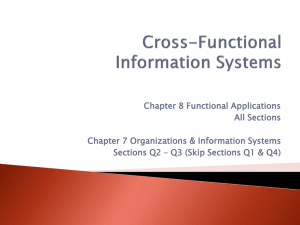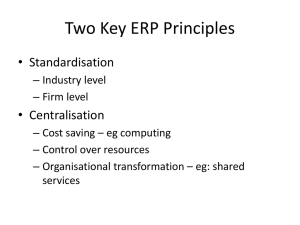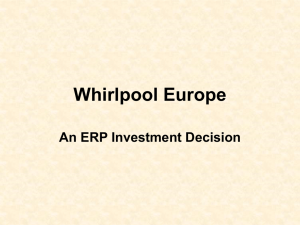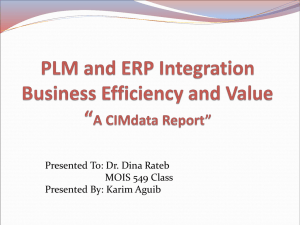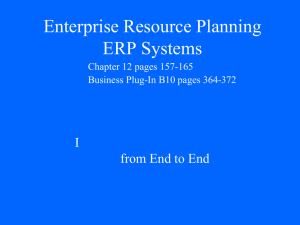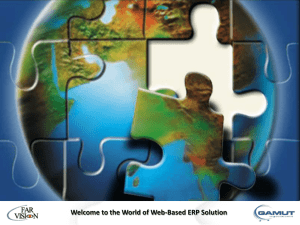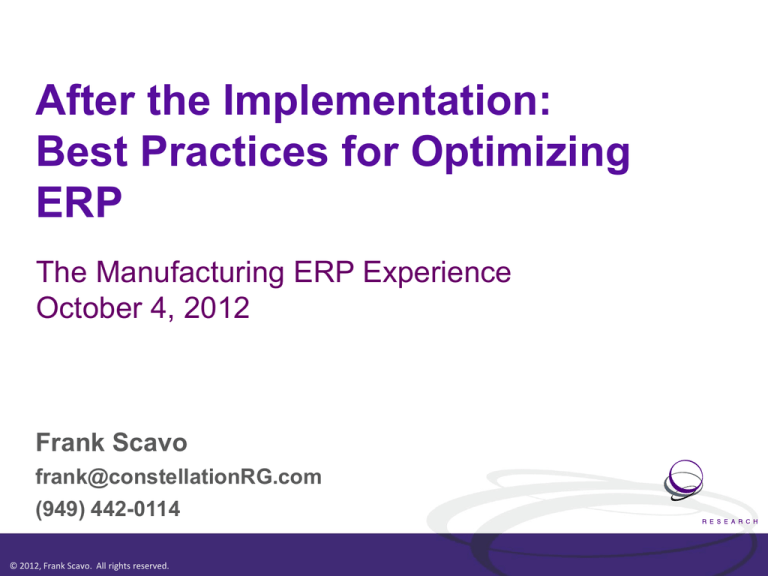
After the Implementation:
Best Practices for Optimizing
ERP
The Manufacturing ERP Experience
October 4, 2012
Frank Scavo
frank@constellationRG.com
(949) 442-0114
© 2012, Frank Scavo. All rights reserved.
About Frank Scavo
•
•
•
•
•
APICS Fellow (CFPIM)
President, Strativa
President, Computer Economics
Principal Analyst, Constellation Research
Blog: Enterprise System Spectator at
http://fscavo.blogspot.com
• Advocate for end-user IT organizations
© 2012, Frank Scavo. All rights reserved.
2
ERP Experience Life Cycle
ERP
Selection
ERP
Implementation
© 2012, Frank Scavo. All rights reserved.
ERP Use
3
What is to “Optimize?”
op·ti·mize:
1. to make as effective,
perfect, or useful as
possible.
© 2012, Frank Scavo. All rights reserved.
4
Optimizing ERP Makes ERP…
• Perfect:
– Fits your business
• Useful:
– People actually use it
– It is worth using
• Effective:
– Has positive effects on
your business
© 2012, Frank Scavo. All rights reserved.
ERP Optimization Case Study:
Midsize Manufacturer
Symptoms
© 2012, Frank Scavo. All rights reserved.
Order entry process
cumbersome
Poor support for returned
material
Sales reporting inadequate
Database row-locking
Serialization of inventory
leading to high transaction
volumes
Some production
processing outside ERP
Poor visibility and costing
of WIP
Manual processes for
MPS/MRP
Poor visibility for nonconforming material
New product information
and engineering changes not
tightly controlled
Poor response time
Purchasing units of measure
conversion done manually
Receiving process requires
re-keying of data
Quality Group can’t keep up
with production volumes
Etc., etc.
6
Tracing Symptoms to Four Root Causes
Wrong
System
System Not
Installed
Correctly
Not “Perfect”
© 2012, Frank Scavo. All rights reserved.
System Not
Being Used
Not “Useful”
System Not
Being Used
Effectively
Not “Effective”
Category #1: The Wrong System
•
•
•
•
Missing functionality
System performance
Not scalable
Bugs
© 2012, Frank Scavo. All rights reserved.
8
Category #2:
Right System, But Not Installed Correctly
•
•
•
•
•
Business processes not configured correctly
System tables incomplete
Product cost elements not detailed enough
Inventory locations not set up
Relevant system options not turned on
© 2012, Frank Scavo. All rights reserved.
9
Category #3:
Right System, But Not Using It
• Unfinished implementation (e.g. “Phase II
Syndrome”)
• Lack of knowledge about system features
• Parts of the old system still in use
• Side systems
© 2012, Frank Scavo. All rights reserved.
10
Category #4:
Right System, But Not Used Effectively
•
•
•
•
•
Data inaccuracy
Lack of user procedures
Poor disciplines
Lack of training
Organizational disincentives
© 2012, Frank Scavo. All rights reserved.
11
Overlapping Root Causes,
Vary by Organization
1. Wrong System
2. Right System, Installed
Incorrectly
3. Right System, Not Being Used
4. Right System, Not Used
Effectively
© 2012, Frank Scavo. All rights reserved.
12
From Our Case Study:
Analysis of Symptoms and Causes
100%
73%
75%
50%
25%
27%
33%
40%
Decision:
Stay with
Current System
But Take
Corrective
Actions
0%
Wrong System Right System, Right System, Right System,
But Installed But Not Used But Not Used
Incorrectly
Effectively
*Adds to more than 100% because some symptoms cross multiple categories
© 2012, Frank Scavo. All rights reserved.
13
Opportunities for Sub-Optimization
Throughout the ERP Life Cycle
ERP
Selection
ERP
Implementation
• Implementation
mistakes
• Picking
wrong • Limiting scope
system
for cost/
schedule
© 2012, Frank Scavo. All rights reserved.
ERP Use
•
•
•
•
•
•
•
•
Changing business requirements
Organic growth
Mergers and acquisitions
Organizational restructuring
New products/services
Changing business model
New demands from customers & suppliers
International expansion
14
The Cost of ERP Must Also Be Optimized
Return
Benefits
ROI =
=
Investment
Cost
© 2012, Frank Scavo. All rights reserved.
15
Cost of ERP is Mostly in Ongoing
Support
Implementation Plus
3-Year Ongoing Support
Ongoing
Support,
79%
Up-Front
Costs,
21%
Implementation Plus
10-Year Ongoing Support
Ongoing
Support,
93%
Up-Front
Costs,
7%
Source: Computer Economics, 2012
Assumptions: 100 user, on-premises ERP system
Upfront Costs: ERP license, data center hdw/sfw, implementation expense
Ongoing Support: ERP maintenance fees, data center hdw/sfw maintenance, ERP staff costs
© 2012, Frank Scavo. All rights reserved.
16
And, Total Cost of ERP Often Exceeds
Expectations
Out of 16 technologies we surveyed in 2011, ERP ranks
WORST in terms cost overrun.
© 2012, Frank Scavo. All rights reserved.
17
How Can We Optimize ERP?
1. Analyze Root Problems
op·ti·mize:
To make as effective,
perfect, or useful as
possible.
© 2012, Frank Scavo. All rights reserved.
2. Identify Corrective Actions
3. Identify Potential Cost
Savings
4. Carry Out an Optimization
Roadmap
18
If You’ve Got the Wrong System…
• Can it be fixed?
– Newer version
– Vendor Patch
– Modification
• Can you work around the
problem?
• Can you supplement the
system?
• Do you need a new system?
© 2012, Frank Scavo. All rights reserved.
If System Was Installed Incorrectly…
• Why?
– Ignorance?
– Trying to make new system
look like the old
– Some other reason?
• Can you change the set
up?
• Do you need to reimplement?
© 2012, Frank Scavo. All rights reserved.
If System Not Being Used…
• Why?
– Old system still in use?
– Lack of training?
– Lack of resources to
implement?
– Resistance to change?
• Solution depends on the
problem
© 2012, Frank Scavo. All rights reserved.
If System Not Used Effectively…
•
•
•
•
© 2012, Frank Scavo. All rights reserved.
Data problems?
Discipline problems?
Integration problems?
Incentive/Measurement
problems?
Postscript: Consider Cloud Deployment
• Facilitate upgrades
• More flexible in accommodating
changes in business volume or
business model
• Sometimes include
development environment for
extending system, without
modifications
• More easily leverage 3rd party
developers
* Source: “The Differences Between Cloud ERP and Hosted ERP and Why They
Matter” Constellation Research, 2012
© 2012, Frank Scavo. All rights reserved.
23
ERP Cost Optimization:
Consolidation is Key
Small Companies
ERP users
IT support
Midsize Companies
• ERP support staff are
more productive in larger
installations
– IT staff in midsize
companies support twice
the number of users as in
small companies
– In large companies, the
ratio triples
• Therefore, combine
multiple ERP systems,
versions, and instances
wherever possible
Source: “ERP Support Staffing Ratios,” Computer Economics, 2011
© 2012, Frank Scavo. All rights reserved.
24
ERP Cost Optimization:
Minimize Code Modifications
ERP Staff Productivity
100%
80%
“Few” or
“No” Mods
Situation worse
if mods cause
organization
to forgo
ERP version
upgrades
“Many” or
“Extensive” Mods
Source: “ERP Support Staffing Ratios,” Computer Economics, 2011
© 2012, Frank Scavo. All rights reserved.
25
ERP Cost Optimization:
Consider Third-Party Maintenance (3PM)
• Vendor margins on software
maintenance can exceed 90%
• Much software maintenance
revenue goes to fund new
development
• Customers who don’t plan to
upgrade may do better with
3PM
• Savings on order of 50%
• 3PM providers may support
customizations
© 2012, Frank Scavo. All rights reserved.
26
ERP Optimization Roadmap
Root Cause
Problem
Analysis
Cost
Optimization
Opportunities
© 2012, Frank Scavo. All rights reserved.
Priorities and task
dependencies
Optimization
Initiatives
Typically 5-20,
depending on severity
of problems and
organizational capacity
for change
Typically 6-18 months
Optimizing ERP Can’t Wait Until
“After the Implementation”
Your ERP selection
and implementation
decisions today will
dictate your
optimization options
for years to come
© 2012, Frank Scavo. All rights reserved.
For Example:
• Pick the right system
• Negotiate to keep your
3PM options open
• Consider cloud
deployment
• Implement correctly
• Limit modifications
• Etc., etc.
28
Thank You!
Frank Scavo
949.442.0114
frank@ConstellationRG.com
Twitter: @fscavo
www.ConstellationRG.com
The Enterprise System Spectator
http://fscavo.blogspot.com
© 2012, Frank Scavo. All rights reserved.


